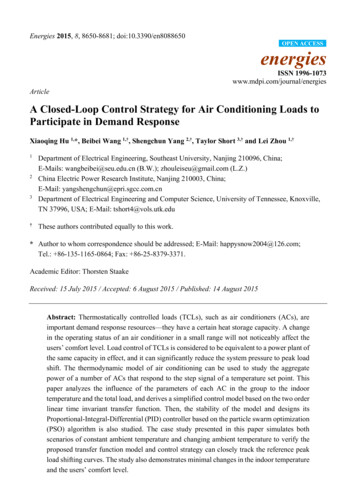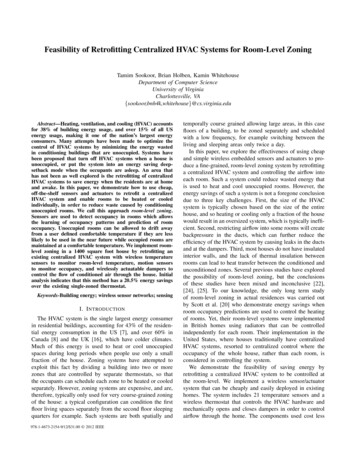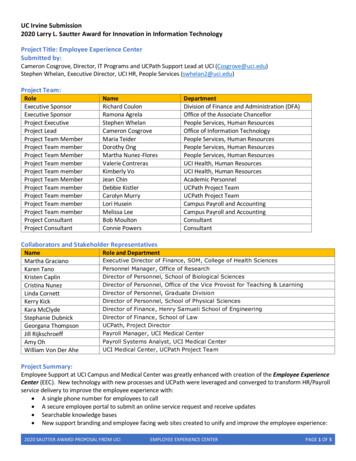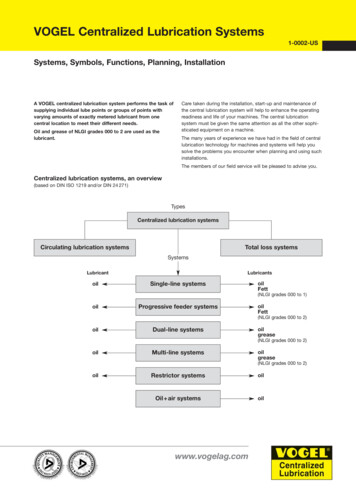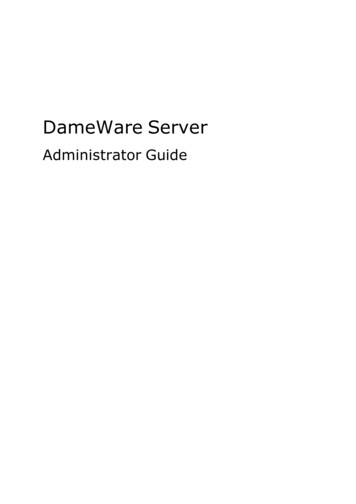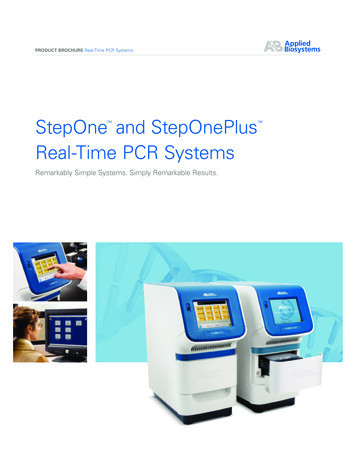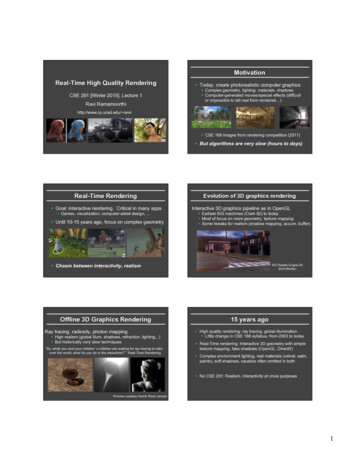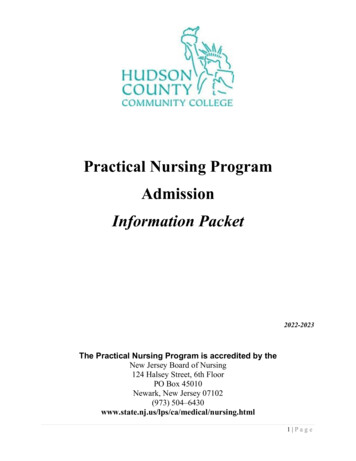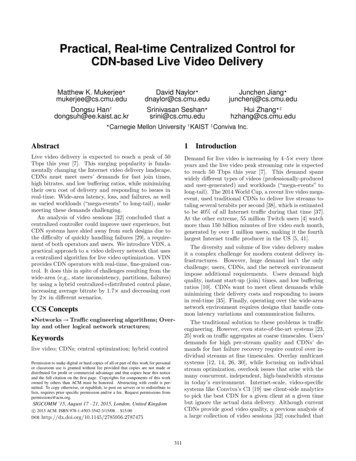
Transcription
Practical, Real-time Centralized Control forCDN-based Live Video DeliveryMatthew K. Mukerjee?mukerjee@cs.cmu.eduDavid Naylor?dnaylor@cs.cmu.eduJunchen Jiang?junchenj@cs.cmu.eduDongsu Han†dongsuh@ee.kaist.ac.krSrinivasan Seshan?srini@cs.cmu.eduHui Zhang?‡hzhang@cs.cmu.edu? CarnegieMellon University † KAIST ‡ Conviva Inc.Abstract1Live video delivery is expected to reach a peak of 50Tbps this year [7]. This surging popularity is fundamentally changing the Internet video delivery landscape.CDNs must meet users’ demands for fast join times,high bitrates, and low buffering ratios, while minimizingtheir own cost of delivery and responding to issues inreal-time. Wide-area latency, loss, and failures, as wellas varied workloads (“mega-events” to long-tail), makemeeting these demands challenging.An analysis of video sessions [32] concluded that acentralized controller could improve user experience, butCDN systems have shied away from such designs due tothe difficulty of quickly handling failures [29], a requirement of both operators and users. We introduce VDN, apractical approach to a video delivery network that usesa centralized algorithm for live video optimization. VDNprovides CDN operators with real-time, fine-grained control. It does this in spite of challenges resulting from thewide-area (e.g., state inconsistency, partitions, failures)by using a hybrid centralized distributed control plane,increasing average bitrate by 1.7 and decreasing costby 2 in different scenarios.Demand for live video is increasing by 4–5 every threeyears and the live video peak streaming rate is expectedto reach 50 Tbps this year [7]. This demand spanswidely different types of videos (professionally-producedand user-generated) and workloads (“mega-events” tolong-tail). The 2014 World Cup, a recent live video megaevent, used traditional CDNs to deliver live streams totaling several terabits per second [38], which is estimatedto be 40% of all Internet traffic during that time [37].At the other extreme, 55 million Twitch users [4] watchmore than 150 billion minutes of live video each month,generated by over 1 million users, making it the fourthlargest Internet traffic producer in the US [5, 41].The diversity and volume of live video delivery makesit a complex challenge for modern content delivery infrastructures. However, huge demand isn’t the onlychallenge; users, CDNs, and the network environmentimpose additional requirements. Users demand highquality, instant start-up (join) times, and low bufferingratios [10]. CDNs want to meet client demands whileminimizing their delivery costs and responding to issuesin real-time [35]. Finally, operating over the wide-areanetwork environment requires designs that handle common latency variations and communication failures.The traditional solution to these problems is trafficengineering. However, even state-of-the-art systems [23,25] work on traffic aggregates at coarse timescales. Users’demands for high per-stream quality and CDNs’ demands for fast failure recovery require control over individual streams at fine timescales. Overlay multicastsystems [12, 14, 26, 30], while focusing on individualstream optimization, overlook issues that arise with themany concurrent, independent, high-bandwidth streamsin today’s environment. Internet-scale, video-specificsystems like Conviva’s C3 [19] use client-side analyticsto pick the best CDN for a given client at a given timebut ignore the actual data delivery. Although currentCDNs provide good video quality, a previous analysis ofa large collection of video sessions [32] concluded thatCCS Concepts Networks Traffic engineering algorithms; Overlay and other logical network structures;Keywordslive video; CDNs; central optimization; hybrid controlPermission to make digital or hard copies of all or part of this work for personalor classroom use is granted without fee provided that copies are not made ordistributed for profit or commercial advantage and that copies bear this noticeand the full citation on the first page. Copyrights for components of this workowned by others than ACM must be honored. Abstracting with credit is permitted. To copy otherwise, or republish, to post on servers or to redistribute tolists, requires prior specific permission and/or a fee. Request permissions frompermissions@acm.org.SIGCOMM ’15, August 17 - 21, 2015, London, United Kingdomc 2015 ACM. ISBN 978-1-4503-3542-3/15/08. . . 15.00DOI: uction
CDN(CDN ctors(Edges(CDN ientVideo(Requests(DNS(AS/Clients(Figure 1: Entities involved in live video distribution. Unlike Conviva’s C3 [19], which focuseson clients, we focus on optimizing CDNs.Figure 2: CDN live content distribution [35].2 Motivation2.1 Settinga centralized video controller algorithm could greatlyimprove end-user experience. Even so, traditional CDNshave shied away from centralized designs due to thedifficulty of providing good performance while quicklyhandling failures in the wide area [29].Unfortunately, past work on live video delivery doesnot meet the practical and real-time requirements ofboth CDNs and users. In summary, we need a live videocontrol plane that: 1) enables proactive control overcost and quality at fine-grained timescales, 2) scalesto today’s largest CDNs and their workloads, 3) achievesreal-time responsiveness to minimize join time andrespond to failures, and 4) meets these goals despitewide-area network delays and failures.In order to address these challenges, we propose a newsystem, called video delivery network (VDN), that allows CDN operators to dynamically control both streamplacement and restrict bitrates automatically, at a veryfine timescale in a WAN environment. Traditionally,clients adapt bitrates independently; VDN gives CDNoperators a say, as they have the best view of currentresources and delivery costs. At its core, VDN uses acentralized algorithm that performs end-to-end optimization of live stream routing. The centralized algorithm isa piece of the larger VDN framework, which mitigatesWAN challenges with a hybrid approach that balancesthe benefits of centralized control with the resilience andresponsiveness of distributed control.We evaluate VDN using traces of real video sessionsfrom multiple live content providers as well as a WANtestbed. We show that, in a variety of scenarios suchas heavy-head (e.g., a sports game) and heavy-tail (e.g.,user-generated streams), VDN provides a 1.7 improvement in average bitrate and reduces delivery costs by2 compared to current CDNs. We scale VDN to 10,000videos and show it can react at a timescale of 200 ms.In summary, our contributions are: A centralized algorithm based on integer programming that coordinates delivery to provide high-qualitylive video streaming at scale while giving control“knobs” to operators to balance cost and quality. A responsive live video delivery framework thatminimizes join time and mitigates WAN challengesusing a hybrid centralized distributed control plane.CDN background: We focus on optimizing CDNsfor HTTP-based live video delivery. Each entity on thevideo delivery path (see Figure 1) can be independentlyoptimized (e.g., clients in Conviva’s C3 [19]), howeverthe focus of this work is CDN optimization.Live video: Live video is particularly challenging due tolack of caching and buffering within the delivery network.In HTTP-based live streaming, a video is encoded atmultiple pre-determined bitrates. At each bitrate, eachstream is broken into multiple 2–10 second chunks, whichclients fetch independently via standard HTTP GETs.Clients typically adapt to network issues by fetchingdifferent bitrates [6].CDN structure: Figure 2 presents the high-level structure of a CDN’s video delivery system [29, 35, 40]. Eachnode represents a cluster of co-located servers. A CDN’sinternal network consists of three logical pieces: videosources that import videos into the system, reflectorsthat forward content internally, and edge clusters thatdirectly serve end-users (individual clients or aggregateASes). Each link has a delivery cost associated with it.These link costs are a result of private business deals,but they tend to be more expensive for source/reflectorlinks (typically long-haul WAN links) and less expensive(some entirely free) for edge/AS links [2]. In Figure 2,the link between A and D is a high cost link.CDNs and DNS: When clients resolve the name of avideo stream, the CDN’s DNS-based client mappingservice maps them to a nearby edge cluster, based on anumber of factors (e.g., load, latency, etc.) [35]. When aclient’s request for a particular channel arrives at an edgecluster, the edge cluster forwards it to a reflector (foundvia DNS), which in turn forwards it to a source (foundvia DNS); the content is returned via the reverse path.When multiple requests for the same content arrive atthe same node (e.g., C in the figure), only one requestis forwarded upwards. The end result is a distributiontree for each video from sources to edge clusters.This has been the design used by Akamai for livestreaming since 2004 [29], externally observed in 2008 [40]and referenced by Akamai in 2010 [35]. We confirm thisholds today [2].312
Content&V1,!300!Problems with modern CDNs: Using DNS to maprequests to the appropriate upstream cluster is very natural as CDN workloads have shifted from web-orientedto live streaming. Mapping clients to edge clusters withDNS makes sense, since most live video content is embedded in websites, which already use DNS. However,using DNS to map internal clusters to upstream clusterscauses issues: 1) CDNs can’t “push” updates to clustersand must instead wait for clusters to “pull” from DNSafter a timeout period (the DNS TTL); and 2) To reduceload on DNS, CDNs group different streams together,reducing granularity [29, 40]. Furthermore, CDNs todayupdate DNS mappings using heuristics [2, 29, 35, 40],impacting performance. We explore these issues in moredetail.DNS TTLs: DNS relies on DNS clients (i.e., clusters) toask for updates when cached DNS results expire (every 30 seconds) [40], preventing a central controller fromsending updates as they are ready. This reduces theefficacy of the controller, thus lowering end-user quality and responsiveness to failures. Furthermore, CDNclusters can spot local network failures long before aTTL-bound DNS update could arrive and thus could react quicker. Lowering the TTL would help approximatea “push”-based system but at the cost of a large increasein the number of DNS queries.Heuristic-based mapping algorithm: A monitoring system collects performance and load information and,based on this knowledge, updates the DNS system everyminute [35]. Generally, CDNs map end-users to edgeclusters based on geography, load, whether or not acluster is already subscribed to the video, and performance relative to the requester [2, 29, 35, 40]. It isimplied that the mapping of edge clusters to reflectorsis done similarly [35], but the specific algorithm is notpublicly known. A measurement study points out thatgeographically close edge clusters all map to the samereflector for the same groups of videos, providing furtherevidence [40]. Additionally, an analysis of video tracesshows that mapping requests based on a global view ofthe network [32] could provide major benefits for endusers, implying that there are opportunities to improvethis mapping.T1!!X!RT3!T2!!ARequests&(A) ,!200!2000!1000!!Y700!!B!A!BResponse&(B) PossibleDistribution!X!Y!A!BVS#Response&(C) PossibleDistributionFigure 3: Motivating central coordination.“mega-events” (e.g., World Cup) serving 1M users [38],(b) TV-style channels serving 100K users [3], and (c)“long tail” user channels (e.g., Twitch, Ustream) serving1-10,000 users [11]. (a) tends to be easier as one tree canserve everyone, whereas workload (c) is the toughest, asit requires coordinating across many videos. VDN mustsupport these workloads, out to a target scale of 10,000channels [40] and 2000 edge clusters [17], beyond thescale of today’s largest CDNs. Such scale is challengingas finding the optimal placement is NP-hard.Fine timescale (responsiveness): VDN must provide fast join time (less than a second) and fast failurerecovery, despite challenges in the wide area (e.g., inconsistent state, partitions, loops).2.3Case for centralized optimizationDespite the lack of public information on how the CDNinternal mapping is done, prior work has shown that acontrol plane designed around centralized optimizationcan provide great benefit [32]. In this section we focuson the reasons for these benefits.Coordination: Throughout this paper, we use coordination to mean the ability to consider all individualstreams simultaneously. As mentioned, modern CDNshave difficulty with this as they aggregate videos and get“locked in” to decisions due to DNS TTLs [40]. Figure 3illustrates why stream coordination can lead to betterresource allocation. Two video channels (V1 and V2 )originate from a single source, S. The goal is to deliverV1 to AS A and V2 to B. Three possible distribution treesexist: T1 , T2 and T3 (Figure 3a). We present two feasibledistribution strategies in Figure 3b and c. In Figure 3bonly client A is served, whereas in Figure 3c both clientsare served. The issue is that using distribution tree T2would congest the RY link. However, knowing this inadvance is difficult; it would require not only knowledgeof network resources, but also the placement of otherstreams. A natural solution would be centralization,which affords both a global view of the network and theability to coordinate streams.This observation generalizes to large-scale networks.Figure 4 compares a system with a global view thatplaces streams independently without coordination (OMin §7) to one that has a global view and coordinatesGoal: VDN’s job is twofold: 1) coordinate the selectionof distribution trees for each channel and 2) assign groupsof clients within a given geographic region to a goodedge server. It must perform these tasks while meetingthe goals listed below.2.2!SDesign goalsVideo-specific quality and low cost (quality/costtradeoff ): CDN operators must satisfy user’s expectation for high video quality, while minimizing theirdelivery cost. Thus, VDN must optimize for video quality directly, while considering its cost.Internet-scale video delivery (scalability): Manydifferent types of workloads exist for live video: (a)313
Gain in Avg. Bitrate (%)120could react to requests immediately, yielding low jointimes and fast failure recovery. However, we argue thata distributed scheme is challenged to provide the highquality demanded by users at reasonable cost, due tothe lack of coordination (§2.3).A combination of the two schemes, with the qualityof a centralized system and the responsiveness of a distributed system would be best suited. We refer to thiscombination as hybrid control. We avoid poor interactions between the two schemes by exploiting propertiesof our highly structured topology (§2.1) and by keepingtrack of alternate paths with enough capacity for eachvideo channel (§4).Coordination100806040200 200246# of Videos (Thousands)810Figure 4: The importance of coordinatingstreams generalizes to larger systems. Thisgraph shows the gain of our system comparedto a multicast-style approach as we’ll see in ) AllAllocations! Y1500!!B!A!BResponse'(B) PossibleDistribution!S!RVS#! Alloc:!X1500!!A3Alloc:!400!!!YVDN reuses existing CDN internal infrastructure (sourceclusters, reflector clusters, edge clusters, and DNS) butemploys a new control plane based on hybrid control—acentralized controller makes optimal decisions slowlywhile clusters simultaneously make decisions quicklybased on distributed state. VDN treats each clusteras an atomic unit (as in Figure 6) and controls thedistribution of live video from sources to clients; trafficmanagement within a cluster is outside the scope of thispaper.When video v is requested at bitrate b by a client inan AS a, a request is sent to VDN’s DNS server; theresponse directs the client to send video chunk requeststo a nearby edge cluster. If this edge cluster knows aboutv (i.e., has a entry for (v, b) in its forwarding table), thenit forwards the request upstream accordingly. If not, itruns the distributed control algorithm (§4). Reflectorspick source clusters similarly. The video chunk followsthis path in reverse. Eventually, centralized controlupdates the clusters’ forwarding tables (§5).As a control plane, VDN (1) populates applicationlayer forwarding tables at each cluster with centrallycomputed entries, (2) creates forwarding table entrieson-the-fly when necessary using distributed control, and(3) updates the client to edge server mapping accordinglyin the DNS infrastructure.!BResponse'(C) PossibleDistributionFigure 5: Motivating app-specific optimization.streams (VDN in §7) for a 100 node topology. With 10Kvideos, we observe up to a 100% improvement in averagebitrate.Application-specific optimization: Generic trafficengineering at a centralized controller is not enough; wemust perform app-specific optimization. For example,in Figure 5, two videos are encoded as low quality (400Kbps) and high quality (1500 Kbps) versions. Due tobandwidth constraints (Figure 5a), we must deliver bothover link RY . We present two ways to allocate bandwidthin Figure 5b and c. Despite fairly allocating bandwidthbetween the streams, Figure 5b does worse overall, asboth clients only receive the low quality stream. Figure 5c is “unfair”, but is a better strategy as one clientis able to get the higher quality stream. Thus, carefulconsideration of bitrate at the granularity of streams isneeded to provide the best quality.From the two examples, we conclude that we can improve quality with: 1) a global view of network resources;2) coordination across streams; and 3) consideration ofthe streaming bitrates. This argues for a video-specificcontrol plane that is logically centralized.2.4VDN system overview3.1DesignPhysical view: VDN introduces two physical pieces tothe traditional CDN infrastructure: a logically centralized central controller and a local agent in each servercluster. The central controller and local agents are eachdecomposed into two pieces: (1) a control subsystemthat computes path assignments based on network stateand (2) a discovery subsystem that tracks incomingrequests and topology information.Case for hybrid controlLive video-specific, centralized optimization alone is notsufficient. A fully centralized system would require newvideo requests to reach the controller across WAN latencies before the video could be viewed, yielding terriblejoin times. Additionally, centralized optimization using an integer program can take quite long (e.g., 10sof seconds), further impacting join time. Yet, a distributed scheme would be highly responsive as clustersLogical view: VDN’s control plane is driven by twocontrol loops, which update clusters’ forwarding tablesat different timescales. A central control loop computesoptimal distribution trees (as well as client/server mappings) using the algorithm described in §5. This loopruns continuously and operates on the timescale of tens314
Controller2ControllerGlobaldiscoveryV1: {S} - {B}V2: {S} - {A,B}Local Agent1 1Input&LocaldiscoveryLocalAgent53DNSGlobal control4 2Local controlOutput&Cluster BCluster AApache Forwarding TableDNSCDN# Global Control Loop# Local Control LoopClientsFigure 6: VDN system overview.Routing Information BaseCentral/Dist.ChannelNext HopCV0/800/*R2DV0/*/*R1VersionEvidenceNetwork StatsViewership Stats15:20Link 1: 10MbpsLink 2: 15MbpsV0:{800}Kbps,3000 requests15:23Link 1: 10MbpsLink 2: failedV0:{800}Kbps,3007 requestsForwarding Information BaseChannel VersionV0/*/*15:23Next HopR1Figure 7: Sample RIB and FIB entries. The local agent uses network and viewer state as “evidence”to decide when to override potentially stale decisions from the central controller.4of seconds to minutes. Meanwhile, the local agent runsa distributed control loop that amends its cluster’s forwarding table to quickly (i.e., sub-second) respond tolocal changes (e.g., link failures) using distributed state.Hybrid controlRunning two control loops in tandem can lead to challenges that destroy any benefit that either control loopswould have had individually, resulting in a “worst of bothworlds” scenario, as hinted in §2.4. When distributeddecision-making is used, hybrid control handles this byonly considering end-to-end paths that provide enoughbandwidth. In this section we examine the interactionsof our central and distributed control loops in detail andhow we balance them, as well as how hybrid controlmitigates issues in the wide-area.Central control loop:1 Local discovery measures link information and tracksAS- and cluster-level channel viewership.2 Global discovery collects measurements from eachcluster and builds a global network view.3 Global control computes optimal distribution trees.4 Local control merges local state with the globaldecision and updates the forwarding table.5 Global control updates DNS.4.1Central controlCentral control takes in a global view of the network(video requests and topology information) as input anduses the algorithm described in §5 to calculate the optimal configuration of distribution trees as output. Toavoid having a single point of failure, VDN uses multiplegeo-replicated controllers, synchronized with Paxos [31].After making a decision, VDN’s central controller distributes it to individual clusters. To do this, the centralcontroller sends each cluster’s local agent a routing information base (RIB) specific to that cluster, as shown inFigure 7. VDN’s RIB contains information to supporthybrid decision-making in addition to the typical routinginformation (e.g., a prefix and a next hop). In particularthe RIB maintains where the information came from(centralized or distributed control), a version number(timestamp), and a set of “evidence” providing the context when this particular RIB entry was computed (linkand viewership information sent by this cluster to theDistributed control loop:1 Local discovery measures link information and tracksAS- and cluster-level channel viewership.2 Local control merges local state with the globaldecision and updates the forwarding table.The two loops have different views of the system, anduse their information for different purposes. The centralloop sees all clusters, the status of their links, and channel viewership information so that it can assign optimaldistribution trees. The distributed loop sees local linkconditions and video requests at one cluster as well asa small amount of distributed state. The local agentmerges the controller’s decision with this informationand installs appropriate forwarding rules. Our hybridcontrol plane strikes a balance between the high quality of a centralized system and the responsiveness of adistributed system.315
Distance & Capacity Tablecentral controller when this decision was computed).Evidence helps distributed control decide if it shouldoverride the global decision.The RIB gets merged with distributed control’s owndecision to become the Forwarding Information Base(FIB), used by the data plane. If distributed controldecides nothing is amiss, the global RIB entry’s (channelprefix, version number, next hop) tuple is used directlyas the FIB entry.Discovery: In order for central control to generategood distribution trees, it needs to have up-to-date information on the state of the network and requests.Keeping track of new requests is relatively simple atthe edge clusters. Estimating changes in link capacityavailable to applications in overlay networks (e.g., duerouting changes, background traffic, or failures) is a wellstudied topic [33, 36, 39], and is thus considered out ofscope in this work.4.2For Node AVia XVia YVia ZTo v0,b11, 5000! 1, 1500! 2, 4500!To v1,b12, 2000! 1, 1500! 2, 4000!To v2,b12, 5000! 1, 1500! 1, 3000!Figure 8: Example of the distributed state tableused in Algorithm 1.Reacting to large changes: If local discovery hasdetected significant changes in the local network stateor viewership used to calculate the most recent centraldecision (i.e., the “evidence” in the RIB entry), it concludes that its current central forwarding strategy is outof date. Specifically, a cluster considers a RIB entrystale if one or more of the following conditions are met: A link referenced in the evidence changes capacityby some percentage (e.g., 20%) set by the operator. A link, node, or controller fails, as detected by atimeout. It receives a request it doesn’t have a FIB entry for.Distributed controlDistributed control keeps track of viewership and pathinformation of upstream neighbors to make quick localdecisions in response to changes in network performance,viewership, and failures. The objective is to improveresponsiveness by avoiding the costly latency of centralized optimization. Thus, distributed control overridesthe central decision in response to dramatic changes.Initial requests (DNS): VDN’s DNS takes into account the user’s geographic location and AS in order tomap them to the proper edge cluster as computed by thecentral controller. If this particular AS has not previously been assigned to an edge cluster, simple heuristicsare used to provide a reasonable starting assignment(e.g., an edge cluster that already is subscribed to thisvideo, an edge cluster that’s typically used by this location/AS, etc.). This provides an initial instant mappingof clients to edge clusters.Distributing state: Clusters distribute video subscription and link information to other nodes via a distancevector-like algorithm to aide in reacting to large changes.Each cluster periodically (e.g., every second) sends allconnected clusters at the next lower layer (see Figure 2)its “distance” from each channel bitrate (v, b), denotedd(v, b), representing how many hops away it is from acluster that is subscribed to v at bitrate b; if a clusteris already subscribed to v at bitrate b, then d(v, b) atthat cluster is 0. Recall that we focus on live video,thus caching is largely unhelpful; clusters only advertisevideos they are currently receiving.When a cluster receives these distance values, it storesthem in a table (see Figure 8) along with the availablecapacity of the bottleneck link on the path to that clusterc(v, b). The cluster propagates the distance to the closestsubscribed cluster with enough path capacity for thisbitrate downwards, similar to a distance vector protocol.Input: request for channel v, bitrate bOutput: next-hop cluster for channel v, bitrate b/* randomly pick a parent that has amin-hop path to (v, b) with enoughcapacity to support delivery*/use f ul : for parent in parents doif d(v, b)via parent min(d(v, b)) andc(v, b)via parent b thenuse f ul use f ul {parent}endendreturn pick at random(use f ul)Algorithm 1: Distributed control algorithm.If the global “evidence” is deemed invalid, a forwardingstrategy is computed by Algorithm 1, using local requestand link information as well as the distributed statefrom upper nodes (Figure 8).For example, when a cluster receives a request for avideo it’s not subscribed to, it uses its table to forwardthe request to the parent “closest” (based on “distance”d() values) to the video that has enough spare path capacity (c()). If there are no paths available the requestis denied, to be serviced by a different edge cluster. Itbreaks ties randomly to avoid groups of clusters potentially overloading a high capacity cluster after failure. Ifthe parent is not already subscribed to the video, theprocess repeats until a subscribed cluster is found. Thealgorithm produces a forwarding strategy that VDNplaces in the RIB and FIB of the cluster for future use(Figure 7). Large-scale link variations, link failures, andnode failures, can all be handled by treating the existingvideos as new requests.316
Discussion: The algorithm ensures that video streamsthat deviate from global control only traverse paths withenough spare capacity to support them. This is criticalbecause it means that (1) if the parent of a clusteris already subscribed to the requested video (and hasample bandwidth to the requesting cluster), requests tothis cluster will not propagate past the parent (i.e., 1hop), (2) more generally, in an n-level CDN (where nis typically 3 today), only n 1 clusters are affected bynetwork / viewership changes as clusters only forward toparents on a path with enough capacity, always reachingsource nodes after n 1 hops, and (3) clusters thatare involved in this algorithm will not be forced todegrade the quality of an existing stream, as we knowthere is enough capacity on the path to support theincoming request. Thus, the distributed algorithm willnot interfere with central control’s already implementeddecisions.Note, through the use of local/global discovery, thecentral controller will eventually become aware of newrequests and failures. By checking evidence in the RIB,clusters will know when central control has “caught up”to the current network state at which point they makethe past local decisions obsolete.4.3Pmax w s Pl L A S ,o O Priorityo Requestl,o Servesl,o w c l L ,o O Cost(l) Bitrate(o) Servesl,osubject to: l L, o O : Servesl,o {0, 1}P l L: o Bitrate(o) Servesl,o Capacity(l)P l L, o O : l 0 InLinks(l) Servesl 0 ,o Servesl,oFigure 9: Integer program at the controller.The optimization is called iteratively (around once aminute) allowing parameters (e.g., measured capacities,link costs, new requests) t
centralized controller could improve user experience, but CDN systems have shied away from such designs due to the di culty of quickly handling failures [29], a require-ment of both operators and users. We introduce VDN, a practical approach to a video delivery network that uses a centralized algorithm for live video optimization. VDN
